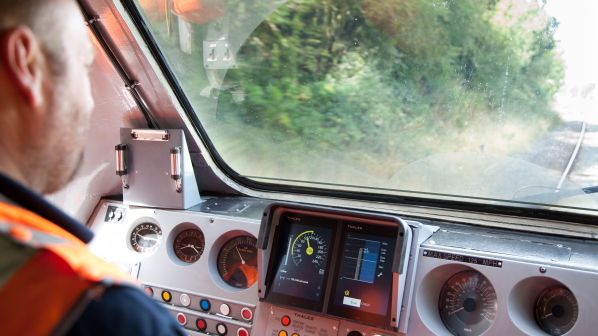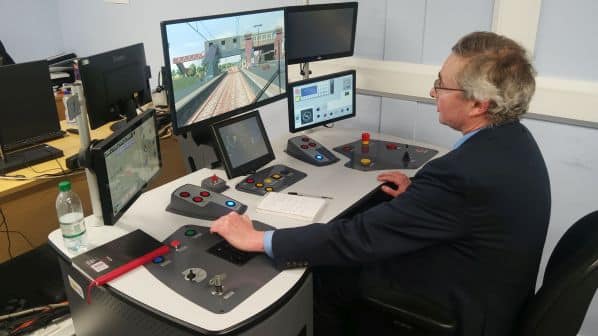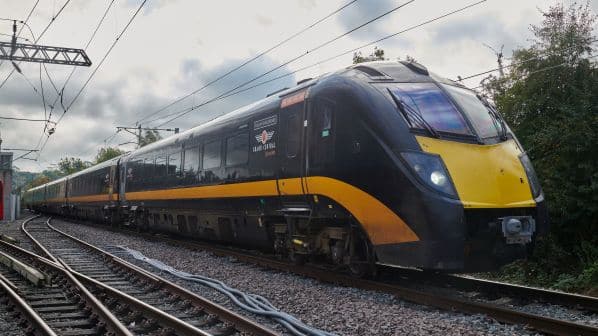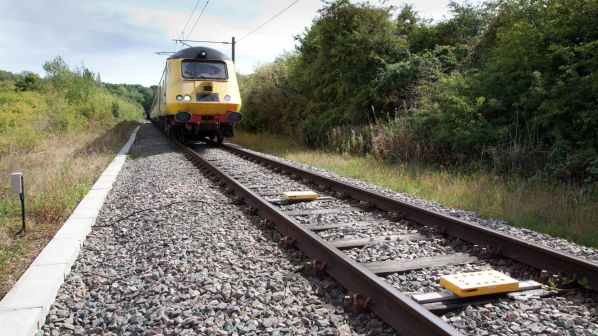THE scale of the challenge facing Britain’s railway sector as it works to deploy ETCS for the first time on a busy mainline used by inter-city passenger services and freight is not lost on Mr Toufic Machnouk, director of the Industry Partnership for Digital Railway at infrastructure manager Network Rail (NR). “This is a once in 200 years event and a massive undertaking,” he says. Crucially, it requires players in what, at times, has been an adversarial, contract-driven industry to work together in partnership.
The East Coast Digital Programme (ECDP) will see NR install ETCS Level 2 on a 160km section of the East Coast Main Line (ECML), running from London King’s Cross as far as Stoke Tunnel, north of Peterborough. As well as inter-city services operated by London North Eastern Railway (LNER), the southern end of the ECML is used by open-access operators Grand Central, Hull Trains and Lumo, and by commuter services operated by Govia Thameslink Railway (GTR). Including freight operators, infrastructure maintenance contractors with on-track plant, and others takes the total number of operators on the ECML to 28, making it “an incredibly representative railway,” according to Machnouk.
With the existing signalling on the southern section of the ECML due for renewal, and a large proportion of the passenger fleet recently delivered with ETCS equipment already installed, NR has taken the opportunity to use the route for its first major deployment of ETCS Level 2 to eliminate lineside signals. It believes ETCS will deliver major benefits by increasing capacity, cutting capital and maintenance costs, and reducing the amount of access to the railway required to maintain signalling equipment.
Major safety benefits are also expected from the continuous monitoring of train speed and track to train communication that ETCS provides, while reducing the amount of signalling maintenance required should also improve trackworker safety. In addition, NR expects ECDP to reduce delays by up to a third and cut CO2 emissions by 55,000 tonnes as steel gantries and other structures will no longer be required for lineside signals.

“We know and understand that ETCS is a superior signalling system,” Machnouk says. “You wouldn’t really think of anything else.” As the major European signalling suppliers have developed the system, costs have come down as the diversity of proprietary systems has been replaced with ETCS. “It creates a more capable railway for less,” Machnouk says.
Stressing that future ECML timetables are subject to wider policy concerns and the need to accommodate the requirements of many different stakeholders, he has no figures for the increase in the number of train paths per hour that ETCS would enable, but does say that a 20% reduction in headways is expected under “a massive capacity enhancement.”
“We know and understand that ETCS is a superior signalling system, you wouldn’t really think of anything else.”
Mr Toufic Machnouk, director of the Industry Partnership for Digital Railway at infrastructure manager Network Rail (NR).
Machnouk believes that the continuous track to train communication that ETCS provides will be “a game changer,” as drivers receive a target speed based on the infrastructure and train movements ahead and the braking characteristics of each particular rolling stock type. As Mr Ollie Turner, head of ERTMS at GTR, says, “you can see round corners. You can see the conditions before you are there.”
ECDP is due for completion in 2029, after the conclusion of regulatory Control Period 7 (CP7) on March 31 of that year, which sets NR’s funding and outputs for the five years from April 1 2024. Running into the start of CP8, ECDP will require a total of £2bn to complete. Following prior investment of £350m, the Department for Transport (DfT) confirmed it would provide £1bn in June 2022 and further investment of £427m is planned in CP7. Infrastructure work represents around 50% of the total cost of ECDP, with business change accounting for 25%, rolling stock 20% and other expenditure 5%.
NR points out that because ECDP covers only 160km of the ECML, the proportion of funding required for infrastructure work is relatively low. ECDP includes a major programme to retrofit rolling stock with onboard ETCS, involving design, installation, testing and approval for many individual train and locomotive classes for the first time. With this work complete under ECDP, the proportion of spending on infrastructure would rise significantly under subsequent phases of the ETCS rollout programme, such as proceeding further north on the ECML towards Doncaster.
Around 70% of the spending on ECDP will reduce the cost of future ETCS deployment programmes. On the savings that the introduction of ETCS will produce, Machnouk says that NR is expecting, on average, a 50% reduction in the capital cost of replacing signalling and a similar reduction in the access required to maintain signalling in future.
National strategy
For its first major ETCS migration programme, NR has adopted what it describes as an integrated industry partnership operating model, in which, as director of the digital railway partnership, Machnouk is responsible for NR’s existing national digital enabling programme as well as ECDP. The aim is to use the experience of NR’s Eastern region with ECDP to establish new national capabilities and strategies that will support other regions and routes in rolling out ETCS in the future.
Machnouk sees the ECDP project as “stress testing” the solutions that are being adopted to meet the many challenges of migrating to ETCS, including project phasing, retrofitting existing fleets with onboard ETCS equipment and training drivers, signalling and maintenance staff on the new system. Operational and business processes will also change. “You’re not going to solve these problems until you tackle them in practice,” he says. For Machnouk, “ECDP will be a fundamental catalyst for solving the challenge of multiple route deployment,” and rather than a single route-specific project, he sees ECDP as “an industrial strategy” that will determine future policy for how signalling is renewed across the national network.
“Change delivery is the biggest thing,” he says, requiring the participation of all industry players, including the infrastructure manager, its contractors and the operators on the ECML, as well as the owners of the rolling stock that operates on the route.
This involves a “deep partnership” with suppliers, who are embedded in the project to produce a less complex structure with only four project layers. They are incentivised to deliver the required system performance, including reducing the need for maintenance access, working on an outcome basis and taking the lead on technical integration.

days of classroom training. Photo: Robert Pritchard
Procurement began in September 2018, and in March 2020 NR announced that it had selected Siemens Mobility as its train control partner (TCP) under a framework contract worth £900m that does not only cover ECDP. As TCP, Siemens is responsible for the design, installation and maintenance of ETCS and associated infrastructure for the lifetime of these assets, as well as technical integration with other existing systems.
Siemens was also appointed as traffic management partner (TMP) under a separate framework contract, where Lot 1 has an estimated value of £108m and Lot 2 a value of £72m. As well as developing a traffic management system for the ECML, Siemens will also work in NR’s North West and Central region to develop traffic management for the Transpennine route.
The rail systems integration partner (RSIP) for ECDP is Atkins, which was awarded a framework contract estimated to be worth £55m. Atkins is responsible for managing integration activities and establishing a collaborative relationship with NR’s East Coast route, the TCP and TMP, and stakeholders including government, passengers, freight operators and rolling stock owners. The RSIP contract also includes the provision of governance and assurance for the programme.
If ECDP is intended to set the course for future ETCS deployment and signalling renewals, then the project has its own pathfinder in the shape of the Northern City Line, a relatively self-contained branch of the ECML running mostly underground for 5.4km from Finsbury Park to Moorgate in the City of London. Testing of ETCS Level 2 began here in 2022 and is expected to be completed shortly, enabling GTR to begin the task of training 250 drivers on the new signalling system this summer (see panel below). When this has been completed and the necessary approvals obtained, lineside signals will be removed and trains will begin carrying passengers under ETCS control in summer 2024.
Govia Thameslink Railway grapples with post-Brexit approvals
AS operator of the Northern City Line (NCL) that is acting as a pathfinder for the East Coast Digital Programme (ECDP), Govia Thameslink Railway (GTR) has been finding its way for the first time through the procedures and processes that other operators will have to follow when seeking approval to place ETCS-equipped rolling stock in service on Britain’s railway network. “How do you assure it, make it safe, get it signed off by the Department for Transport (DfT) and the Office of Rail and Road (ORR); that is one of the bigger headaches,” says Mr Ollie Turner, head of ERTMS at GTR.
GTR has been working with ORR, Britain’s rail safety regulator, for two years and on February 23 made its submission to ORR to obtain an Authorisation to Place into Service (Apis) for its class 717 EMU fleet operating at ETCS Level 2 on the NCL. This was a year later than originally planned, according to a presentation given on March 7 to the first ECDP workshop on obtaining onboard authorisation by GTR safety and compliance engineer, Mr Nigel Hodgson.
“The industry is learning how to implement this technology,” Turner says. “It’s been complicated.” One of the primary causes of delay has been changes to the National Technical Rules (NTRs) for vehicles made since the class 717 was first put into service in March 2019. NTRs are supplemental to the National Technical Specification Notices (NTSNs) published by the DfT, which came into effect on January 1 2021 to replace Technical Specifications for Interoperability (TSIs) after Britain left the European Union. GTR had to obtain a derogation from the NTRs from the Rail Safety and Standards Board (RSSB).
To obtain an Apis, GTR has also been required to complete ETCS System Compatibility (ESC) checks, performed prior to Brexit by the European Union Agency for Railways (ERA). “That process has been tough,” Turner says. “Nobody in the industry knows where they stand post-Brexit.”
The ECS checks required on the NCL could not be produced before the lineside ETCS equipment had been approved, so GTR tested a class 717 EMU on the central core of the Thameslink network, where ETCS has been installed to provide ATO. It followed a Network Rail (NR) specification for this section of Thameslink and had its ESC work reviewed by an Approved Body.
“We need to do better,” says Turner, and GTR is sharing its experience with the other operators involved in ECDP that will all have to go through the same process. “We’re trying to be as open and as honest as we possibly can,” he says. “GTR, ORR and Network Rail have done the hard work on this. That’s the whole idea. Getting the approvals process nailed down for the industry, that would be my legacy.”
Meanwhile, GTR is preparing to start training 250 drivers this summer in preparation for passenger services to run under ETCS on the NCL in summer 2024. It has already deployed a pool of 19 testing and commissioning drivers who worked on the Thameslink core and are “the real experts on ETCS,” according to Turner.
ETCS training will involve two days in the classroom at Hornsey depot, where desktop simulators have been installed, followed by three days of practical training in the field. An ETCS Baseline 2.3.0d overlay is being used for driver training, which will then migrate to Baseline 3.6.0 when the lineside signals are removed.
Further north along the ECML, new lineside equipment is being installed on the 18km section between Welwyn Garden City and Hitchin. Infrastructure work here is due to be completed in 2024 and once sufficient trains have been retrofitted with ETCS and driver training has been completed, migration to the new system will start in 2025 for completion in 2027.
The exact phasing strategy to complete the ECDP programme beyond Hitchin by 2029 is still being developed, Machnouk reports, “as there is no necessity to go one way or the other.” The next phases may include the section from Biggleswade to Fletton, just south of Peterborough, or the loop off the ECML running from Alexandra Palace to Stevenage via Hertford North. In any event, migration to ETCS between Welwyn Garden City and Hitchin is expected to bring immediate capacity benefits, the reduction in headways relieving the bottleneck where the four tracks of the ECML become only two over Welwyn Viaduct and through the tunnels north of Welwyn North station.

fitted with Alstom Atlas 2 ETCS.
ETCS Baseline 3.6.0 is being installed as an overlay parallel to the working railway, which Machnouk likens to working on a greenfield site, enabling train operations to switch over to the new system once driver training has been completed. This will also require sufficient rolling stock to be retrofitted with ETCS onboard equipment, or where it had been installed from new, to be upgraded to Baseline 3.6.0. This is mainly a software upgrade, Machnouk says, but moving from Baseline 2 to Baseline 3 does require some changes, such as to the Driver-Machine Interface (DMI), the in-cab screen that displays the target speed and other information to the driver.
Rolling stock retrofit
Around 80% of the ECML passenger fleet is already equipped with ETCS, notably the 115 class 700 and 25 class 717 EMUs built by Siemens and operated by GTR, and the 65 Hitachi Azuma trains operated by LNER, of classes 800, 801/1 and 801/2. Retrofitting ETCS to older passenger trains, the freight fleet, on-track plant and heritage locomotives, involving a total of 700 vehicles of 60 different classes or subclasses, is what Machnouk sees as ECDP’s biggest challenge, involving operators, fleet owners and suppliers. “It has taken a huge amount of effort to mobilise the partnership,” Machnouk says. “You’ve got to integrate these organisations.”
“It is a whole change affecting thousands of people, and it requires a cross-cultural approach,”
Toufic Machnouk
In 2022 testing began at NR’s Rail Innovation and Development Centre (RIDC) in Melton Mowbray of the first two rolling stock types to be equipped with ETCS under the DfT-funded First in Class (FiC) fitment programme. The first trials were of a class 180 DMU operated by Grand Central, owned by leasing company Angel Trains and fitted with Alstom Atlas 2 ETCS. This was followed by the class 43 HST power cars that form part of NR’s New Measurement Train, fitted with Thales equipment in what NR says is the first application in Britain of onboard ETCS from this supplier. Ricardo has carried out integration design for all class 43 types, under a project managed under NR’s instruction by Porterbrook as the lead rolling stock leasing company for the class 43 under the National Joint Rosco Programme (NJRP).
“We are progressing with these projects,” Machnouk says, “and we expect to complete them in the coming months.” Testing is due to begin this year under what he describes as a “very important” FiC project, namely the class 66 that is the largest locomotive class in Britain and forms half of the national freight fleet. DB Cargo UK is leading on the class 66 FiC project, as it will for classes 60, 67 and 325.
Another significant FiC project now at its early stages covers the class 387 EMU. GTR operates a fleet of 29 on the ECML, but a total of 107 class 387 Electrostars were built by Bombardier and they are also in service with Gatwick Express, Great Western Railway and Heathrow Express.
Other examples of how ECDP is laying the foundations for deploying ETCS on other lines in the future include the extensive training programmes it will require for 3000 drivers and other staff, and the business change procedures that migrating to the new system will involve. “It is a whole change affecting thousands of people, and it requires a cross-cultural approach,” Machnouk says.
The masterplan that ECDP intends to provide for rolling out ETCS in Britain will not just unlock more capacity on busy mixed-traffic routes, he says, but will build much wider capability within the industry, providing its staff with new skills and hopefully attracting new entrants with the digital skills that Britain’s railway will require in the years to come.

